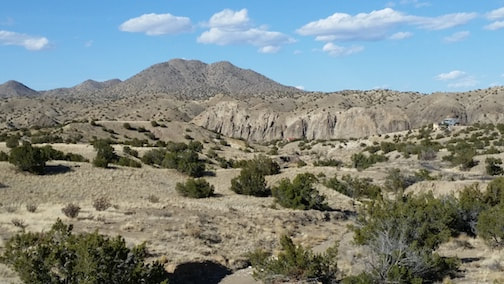On Sunday, March 4, at 11:00 a.m. I will be leading a short geology walk in Cerrillos Hills State Park, which is about 35 minute’s drive south of Santa Fe, on NM 14, the Turquoise Trail.
And turquoise is one of the reasons this area is so fascinating. At a prehistoric site in Alta Vista, Mexico, northwest of Mexico City, there are Aztec artifacts containing turquoise chemically fingerprinted to Cerrillos, dated at 700 CE – 13 centuries ago! When the Spanish arrived in 1535, Mount Chalchihuital, one of the cerrillos, hosted the largest open pit mine of any metal or mineral in North America. (Bauer and Giles, 1995)
We won’t be able to walk as far back as this mine, but we’ll be walking past a few open prospect pits from the lead-zinc-silver boom of 1879. From a geologist’s viewpoint, the Cerrillos Hills are a unique window into the distended underbelly of a small volcanic field whose cones have long since eroded away, leaving the “plumbing” exposed on the arid, juniper-studded hillsides. We can examine the signs of an ancient system of hot springs – the same signs that attracted early prospectors – and take a look at some subvolcanic rocks with unusual textures and compositions.
Plus it’s just a nice place to have a walk on a late winter Sunday.
And turquoise is one of the reasons this area is so fascinating. At a prehistoric site in Alta Vista, Mexico, northwest of Mexico City, there are Aztec artifacts containing turquoise chemically fingerprinted to Cerrillos, dated at 700 CE – 13 centuries ago! When the Spanish arrived in 1535, Mount Chalchihuital, one of the cerrillos, hosted the largest open pit mine of any metal or mineral in North America. (Bauer and Giles, 1995)
We won’t be able to walk as far back as this mine, but we’ll be walking past a few open prospect pits from the lead-zinc-silver boom of 1879. From a geologist’s viewpoint, the Cerrillos Hills are a unique window into the distended underbelly of a small volcanic field whose cones have long since eroded away, leaving the “plumbing” exposed on the arid, juniper-studded hillsides. We can examine the signs of an ancient system of hot springs – the same signs that attracted early prospectors – and take a look at some subvolcanic rocks with unusual textures and compositions.
Plus it’s just a nice place to have a walk on a late winter Sunday.



 RSS Feed
RSS Feed
